このページは、歴史や文化の物語を楽しみながら、その文脈の中で重要な英単語を自然に学ぶための学習コンテンツです。各セクションの下にあるボタンで、いつでも日本語と英語を切り替えることができます。背景知識を日本語で学んだ後、英語の本文を読むことで、より深い理解と語彙力の向上を目指します。

【ご注意】
この記事には、健康、金融、法律など、読者の人生に大きな影響を与える可能性のある情報が含まれています。内容は一般的な情報提供を目的としており、専門的なアドバイスに代わるものではありません。重要な判断を下す前には、必ず資格を持つ専門家にご相談ください。
急激な円高や円安を抑えるために、政府・日銀が市場で為替の売買を行う「為替介入」。その目的と、効果をめぐるdebate(議論)。
この記事で抑えるべきポイント
- ✓為替介入とは、政府・中央銀行が外国為替市場で通貨を売買し、為替相場の急激な変動を抑えようとする政策手段であること。
- ✓介入の目的は、輸出入企業や国民生活に悪影響を及ぼす「過度な変動」や「投機的な動き」を緩和することにあり、相場の長期的な水準を操作することではない、という見方が一般的です。
- ✓為替介入の権限は財務大臣にあり、実際の市場での売買(オペレーション)は日本銀行が担うという役割分担が存在します。
- ✓介入の効果については専門家の間でも様々な議論(debate)があり、市場規模の大きさから単独介入の効果は限定的とされる一方、他国と協力する「協調介入」はより大きな影響力を持つと考えられています。
- ✓為替介入は万能薬ではなく、その国の金融政策(monetary policy)など、より根本的な経済政策と組み合わせて行われることが重要とされています。
為替介入 ― なぜ政府は円を売買するのか
ニュースで頻繁に耳にする「政府・日銀が為替介入を実施」という言葉。しかし、なぜ国が自国の通貨を売買するのでしょうか?急激な円安や円高は、私たちの生活や経済に大きな影響を及ぼします。本記事では、こうした状況で発動される為替介入の基本的な仕組みから、その目的、そして効果をめぐる国際的な議論までを、わかりやすく紐解いていきます。
Currency Intervention — Why Does the Government Buy and Sell the Yen?
We often hear the phrase "the government and the Bank of Japan conducted a currency intervention" in the news. But why does a country buy and sell its own currency? Rapid appreciation or depreciation of the yen can have a significant impact on our lives and the economy. This article will unravel the basic mechanism of currency intervention, which is triggered in such situations, from its purpose to the international debates surrounding its effectiveness, in an easy-to-understand manner.
為替介入とは? ― 市場に働きかける政府の「一手」
まず、為替介入(intervention)とは、政府や中央銀行が為替相場の安定を目指し、外国為替市場(market)で直接、通貨の売買を行う政策のことです。その目的は、相場の急激すぎる変動を抑制し、経済の安定化(Stabilization)を図ることにあります。例えば、急激な円高が進むと、輸出企業の収益が悪化する恐れがあります。この場合、政府・日銀は「円売り・外貨買い介入」を行い、市場に出回る円の量を増やして円の価値を相対的に下げようとします。逆に、昨今のような円安局面では、輸入品の価格が高騰し国民生活を圧迫するため、「円買い・外貨売り介入」によって円の価値を支えようとします。
What Is Currency Intervention? — The Government's "Move" to Influence the Market
First, currency intervention is a policy where a government or central bank directly buys and sells currency in the foreign exchange market to stabilize exchange rates. Its purpose is to curb excessively rapid fluctuations in the exchange rate and achieve economic stabilization. For example, if the yen appreciates rapidly, it could hurt the profitability of exporting companies. In this case, the government and the Bank of Japan would conduct a "yen-selling, foreign-currency-buying intervention" to increase the amount of yen in circulation and relatively lower its value. Conversely, in a phase of yen depreciation like we've seen recently, the prices of imported goods soar, putting pressure on people's lives. In this scenario, a "yen-buying, foreign-currency-selling intervention" is used to support the yen's value.
誰が、なぜ介入を決断するのか? ― 政府と中央銀行の役割
では、この重要な決定は誰が行うのでしょうか。日本では、為替介入に関する最終的な決定権限(authority)は財務大臣にあります。そして、財務大臣の指示に基づき、日本の中央銀行(Central Bank)である日本銀行が、市場で実際に通貨を売買するオペレーションを執行します。このように、政策決定を行う「政府」と、実務を担う「中央銀行」という役割分担が明確に定められているのです。介入の原資となるのは、政府が管理する「外国為替資金特別会計」であり、ここにはドルなどの外貨建て資産が蓄えられています。円買い介入の際には、この外貨準備を使って特定の通貨(currency)である円を買い支えることになります。
Who Decides to Intervene and Why? — The Roles of the Government and Central Bank
So, who makes this important decision? In Japan, the ultimate authority to decide on currency intervention rests with the Minister of Finance. Based on the Minister's instructions, the Bank of Japan, which is Japan's central bank, executes the actual currency trading operations in the market. Thus, there is a clear division of roles: the "government," which makes policy decisions, and the "central bank," which handles the practical implementation. The funds for intervention come from the "Foreign Exchange Fund Special Account" managed by the government, which holds assets denominated in foreign currencies like the U.S. dollar. During a yen-buying intervention, these foreign reserves are used to buy and support a specific currency, the yen.
介入の効果と限界 ― 終わらない「Debate(議論)」
為替介入の有効性については、専門家の間で長年にわたり活発な議論(debate)が続いています。肯定的な意見としては、介入が市場参加者に対して「当局はこれ以上の急激な変動を容認しない」という強いシグナルを送ることで、過度な動きに歯止めをかける効果があるというものです。一方で、世界の外国為替市場は1日に数兆ドルもの取引が行われる巨大な空間であり、一国が投じる資金だけで相場の大きな流れを変えるのは困難だとする懐疑的な見方も根強くあります。特に、日本が単独で行う「単独介入」の効果は限定的とされることが多く、複数の国が足並みをそろえて行う「協調介入(Coordinated Intervention)」の方が、市場に与えるインパクトは大きいと考えられています。
The Effects and Limits of Intervention — The Endless "Debate"
The effectiveness of currency intervention has been the subject of a lively and long-standing debate among experts. A positive view is that intervention sends a strong signal to market participants that "the authorities will not tolerate further rapid fluctuations," which helps to curb excessive movements. On the other hand, there is a persistent skeptical view that since the global foreign exchange market is a massive space with trillions of dollars traded daily, it is difficult for a single country's funds to change the major trend of the market. In particular, the effect of "unilateral intervention" conducted by Japan alone is often considered limited, while "coordinated intervention," where multiple countries act in concert, is thought to have a much larger impact on the market.
投機との戦い、そして金融政策との連携
為替相場の急変動の背景には、しばしば短期的な利益を狙った投機(speculation)的な取引の存在が指摘されます。為替介入は、こうした過度な投機によって市場が実体経済からかけ離れてしまうのを防ぐという側面も持っています。しかし、介入はあくまで一時的な影響を与える対症療法に過ぎないという見方が一般的です。より根本的な解決のためには、金利の調整などを通じて経済全体に影響を及ぼす金融政策(monetary policy)との連携が不可欠とされています。為替レートは二国間の金利差など、よりマクロな経済要因によって動くため、介入だけで長期的なトレンドに抗うことはできないのです。
The Battle with Speculation and Coordination with Monetary Policy
Behind rapid exchange rate fluctuations, the existence of speculative trading aimed at short-term profits is often pointed out. Currency intervention also has the aspect of preventing the market from deviating too far from the real economy due to such excessive speculation. However, the general view is that intervention is merely a temporary, symptomatic treatment. For a more fundamental solution, coordination with monetary policy, which affects the entire economy through measures like interest rate adjustments, is considered essential. Exchange rates are driven by more macro-economic factors, such as interest rate differentials between two countries, and intervention alone cannot fight a long-term trend.
結論
為替介入は、グローバル経済の不確実性から自国経済を守るための重要な政策手段です。しかし、その効果には限界もあり、決して万能薬ではありません。この政策が発動される背景には、どのような経済状況があり、政府が何を意図しているのか。そして、国際社会との力学がどう絡んでいるのか。為替介入という「一手」を理解することは、日々の経済ニュースをより深く、多角的に読み解くための鍵となるでしょう。
Conclusion
Currency intervention is an important policy tool for protecting a country's economy from the uncertainties of the global economy. However, its effects have limits, and it is by no means a panacea. Understanding the economic conditions behind the activation of this policy, the government's intentions, and the dynamics with the international community is key. Grasping this policy "move" will allow you to read daily economic news with greater depth and from multiple perspectives.
テーマを理解する重要単語
debate
「議論」や「討論」を意味し、為替介入の有効性を巡って専門家の意見が分かれている状況を示しています。この単語は、介入が万能ではなく、その効果について肯定的な見方と懐疑的な見方の両方が存在することを浮き彫りにします。物事を多角的に捉える重要性を示唆する言葉です。
文脈での用例:
There was a heated debate in parliament over the new bill.
新しい法案をめぐって、議会で白熱した討論があった。
authority
「権限」や、複数形で「当局」を意味します。この記事では、為替介入の最終的な決定権限が財務大臣にあることを示しており、政策決定のプロセスを理解する上で不可欠です。誰がどのような力を持っているのか、という政府内の役割分担や統治の仕組みを読み解く鍵となる単語です。
文脈での用例:
The professor is a leading authority on ancient history.
その教授は古代史に関する第一人者(権威)だ。
intervention
本記事の主題そのものである「為替介入」を指す最重要単語です。政府や中央銀行が市場に直接的に働きかける行為を意味し、その目的や効果を巡る議論の出発点となります。この単語を理解することで、なぜ国が通貨を売買するという異例の措置を取るのか、その背景にある意図を深く読み解くことができます。
文脈での用例:
The UN's military intervention was aimed at restoring peace in the region.
国連の軍事介入は、その地域の平和を回復することを目的としていた。
currency
「通貨」を意味し、円やドルなど、為替介入の直接的な対象物を指します。この記事では、自国通貨である円の価値を安定させるために、政府が外貨を売買する仕組みが解説されています。国際経済や金融ニュースを理解する上で、最も基本的かつ中心的な語彙の一つと言えるでしょう。
文脈での用例:
The Japanese Yen is a stable currency in the global market.
日本円は世界市場で安定した通貨です。
speculation
短期的な利益を狙った売買、すなわち「投機」を指します。為替相場が、その国の経済実態からかけ離れて大きく変動する要因の一つとして指摘されています。為替介入が、こうした過度な投機を抑制する目的も持つことを理解することで、市場の複雑な動きの一端を垣間見ることができます。
文脈での用例:
The stock market boom was driven by speculation rather than by genuine investment.
株式市場の好景気は、真の投資よりも投機によって引き起こされた。
unilateral
「単独の」という意味で、この記事では日本が一国だけで行う「単独介入」を指します。その効果は限定的とされ、複数の国が協力する「協調介入」と対比されています。この単語を通じて、グローバルな為替市場において一国の力には限界があり、国際協調が重要になるという力学を理解することができます。
文脈での用例:
The company made a unilateral decision to close the factory without consulting the workers.
会社は労働者に相談することなく、工場を閉鎖するという一方的な決定を下した。
depreciation
通貨価値の「下落」、すなわち「円安」を指す経済用語です。この記事では、円安が輸入品価格の高騰を招き、国民生活を圧迫する状況が説明されています。対義語であるappreciation(価値の上昇、円高)とセットで覚えることで、為替の動きを正確に捉えるための語彙力が身につきます。
文脈での用例:
The rapid depreciation of the yen led to higher prices for imported goods.
急激な円安(円の価値下落)は、輸入品価格の上昇につながった。
panacea
ギリシャ神話の癒やしの女神の名に由来する「万能薬」という意味の言葉です。この記事の結論部分で、為替介入は重要だが全ての問題を解決する魔法の杖ではない、という限界を的確に表現するために使われています。知的なニュアンスを持つため、議論の締めくくりなどで効果的に使える語彙です。
文脈での用例:
Technology is not a panacea for all our problems.
テクノロジーは我々のすべての問題に対する万能薬ではない。
central bank
「中央銀行」を指し、日本では日本銀行(日銀)がこれにあたります。記事では、財務大臣の指示に基づき、実際に市場で通貨売買を執行する「実務部隊」としての役割が解説されています。金融政策の主体でもあり、経済ニュースを理解するためには必須の基礎知識と言えるでしょう。
文脈での用例:
The central bank is responsible for maintaining the stability of the financial system.
中央銀行は金融システムの安定を維持する責任がある。
monetary policy
中央銀行が金利の調整などを通じて経済全体に影響を及ぼす「金融政策」。記事では、為替介入が一時的な対症療法に過ぎず、より根本的な解決には金融政策との連携が不可欠だと論じられています。この二つの政策の関係性を理解することが、記事の核心を掴むための鍵となります。
文脈での用例:
The central bank uses monetary policy to control inflation.
中央銀行はインフレを抑制するために金融政策を用いる。
stabilization
「安定化」を意味し、為替介入の最大の目的を表すキーワードです。急激すぎる円高や円高といった相場の過度な変動を抑制し、経済を安定した状態に導くという政策意図を明確に示しています。この記事を通じて、なぜ「安定」が経済にとって重要なのかを考えるきっかけとなる単語です。
文脈での用例:
The main goal of the policy is the stabilization of the national economy.
その政策の主たる目標は、国家経済の安定化です。
denominated
「〜建ての」と訳され、ある金融資産がどの通貨単位で価値を計られているかを示します。この記事では、介入の原資となる外貨準備がドルなどの外貨建てであることを説明するのに使われています。契約書や金融商品の説明など、国際的な経済活動の文脈で頻出する重要な専門用語です。
文脈での用例:
The government holds assets denominated in foreign currencies like the U.S. dollar.
政府は米ドルのような外貨建ての資産を保有している。
coordinated
「協調した」という意味で、複数の国が足並みをそろえて行う「協調介入」を表します。単独介入(unilateral intervention)よりも市場への影響力が大きいとされており、国際社会の連携の重要性を示す単語です。為替問題が単なる一国のものではなく、国際的な課題であることを教えてくれます。
文脈での用例:
A coordinated intervention by several central banks has a greater impact on the market.
複数の中央銀行による協調介入は、市場により大きなインパクトを与える。